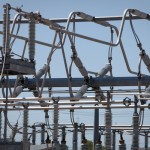Power Plant Shutdowns, Delays Could Mean More Blackouts Next Year
The Electric Reliability Council of Texas, which oversees much of the state’s power, released projections this week for grid reliability over the coming years. ERCOT says rolling blackouts like the ones we had last winter remain a possibility. The report includes a list of energy projects that it expected to be online by now but are still on hold, adding to the state’s power crunch.
A coal plant that was supposed to come online east of Waco will not be generating power, according to the council. An accident at the Sandy Creek coal plant during a commissioning test has caused damage to equipment that will keep the plant offline until the spring of 2013, says ERCOT CEO Trip Doggett. “We just learned of that in the past few weeks,” he says, “that was a significant surprise.” What exactly happened at the plant? “I don’t have intimate details there,” Doggett says, noting that they had been told about it during the past few weeks.
Because of the Sandy Creek delay, ERCOT will not have access to over 900 megawatts of power for the Texas grid by next year, “which is a very significant chunk of our reserve that we were expecting to be available,” Doggett says.
On top of the Sandy Creek delay, two other coal plants run by Luminant, Monticello 1 and 2 in Northeast Texas, announced in September that it will shut down this winter, citing upcoming EPA emissions rules. The EPA said at the time that they had worked with Luminant to reach a “no-shut down, no layoff solution.” “It is unfortunate that company leadership rushed to a decision that needlessly puts their workers’ jobs at risk,” Gina McCarthy, the EPA’s air quality chief, said in a statement. “It’s not EPA’s role to tell private companies what business decisions to make, but we firmly believe that there are better alternatives for Luminant.”
The pending Luminant shutdown and Sandy Creek delay mean steep cuts to the grid’s reserves, putting them 2600 MW short of their goal. Ideally, ERCOT would like to have a 13.75 percent reserve margin of electricity to protect it from rolling blackouts on high energy use days, but the council is projecting next year’s reserves will be closer to 12 percent for 2012. “The magnitude of this drop was not expected,” Doggett said. “If we have the same weather and same outage patterns this summer, just the absence of those two [Luminant] units would result in rotating outages.”
Another reason for the revised estimates of power reserves has to do with weather. “The demand forecast in this report — with normal weather — has increased because normal weather looking back for the last fifteen years now includes last summer, the hottest on record,” Doggett said. “It’s raised the definition of “normal weather” for the forecasting.”
Another of the delayed projects affecting ERCOT’s projections is the 720-acre Pflugerville Solar Farm, which plans to produce 60 megawatts of power once it’s up and running. That’s enough for about 40,000 homes, according to the company. It was due to start generating electricity at the end of this year, but those plans have been pushed back. Why the delay?The group behind the farm, RRE Austin Solar, says that they still need someone to sign a Power Purchase Agreement with them, a contract saying they will buy the electricity once it’s online. “Once we find somebody to purchase the power and secure that [agreement], construction can begin immediately depending on their needs and power could be ready for sale within 12 months,” said Valerie Harkins, project developer for the company.
But even if those 60 megawatts were already flowing into the Texas grid, they would do little to help the state avoid projected rolling blackouts. During the biggest day of power use last summer, the state used 68,369 megawatts of electricity at its peak.
A map of the RRE Austin Solar Pflugerville site:




